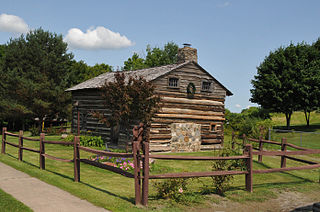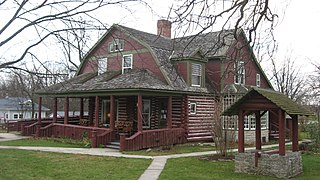
Abraham Lincoln Birthplace National Historical Park is a designated U.S. historic park preserving two separate farm sites in LaRue County, Kentucky, where Abraham Lincoln was born and lived early in his childhood. He was born at the Sinking Spring site south of Hodgenville and remained there until the family moved to the Knob Creek Farm northeast of Hodgenville when he was two years old, living there until he was seven years of age. The park's visitor center is located at the Sinking Spring site.

Scenic State Park is a Minnesota state park near Bigfork in Itasca County. It encompasses 3,936 acres (1,593 ha) of virgin pine forests that surround Coon and Sandwick Lakes. It also includes portions of Lake of the Isles, Tell Lake, Cedar Lake and Pine Lake. Established in 1921, the Ojibwe tribe had previously used the area for hunting. The park has places for camping, hiking, swimming, fishing, and canoeing.

Sequoyah's Cabin is a log cabin and historic site off Oklahoma State Highway 101 near Akins, Oklahoma. It was the home between 1829 and 1844 of the Cherokee Indian Sequoyah, who in 1821 created a written language for the Cherokee Nation. The cabin and surrounding park, now owned by the Cherokee Nation, was declared a National Historic Landmark in 1965.

The Black Moshannon State Park Historic Districts are three separate historic districts on the National Register of Historic Places (NRHP) at Black Moshannon State Park in Rush Township, Centre County, Pennsylvania in the United States. The structures in the historic districts were constructed in the 1930s during the Great Depression by the Civilian Conservation Corps (CCC). The three districts are: the Beach and Day Use District, with 18 contributing structures, including 11 different picnic pavilions, concession building, bathhouse, museum, and four open pit latrines; the Family Cabin District with 16 contributing properties, including 13 cabins, one lodge and two latrines; and the Maintenance District with four contributing properties, including a storage building, three-bay garage, gas pump house, and ranger's residence.

The Kennedy Farm is a National Historic Landmark property on Chestnut Grove Road in rural southern Washington County, Maryland. It is notable as the place where the radical abolitionist John Brown planned and began his raid on Harpers Ferry, Virginia, in 1859. Also known as the John Brown Raid Headquarters and Kennedy Farmhouse, the log, stone, and brick building has been restored to its appearance at the time of the raid. The farm is now owned by a preservation nonprofit.

Woodland is a historic house on the grounds of Sam Houston State University in Huntsville, Texas. Built in stages beginning about 1847, it was the residence of Sam Houston from 1847 to 1859. The house is now part of Sam Houston Memorial Museum, and is a National Historic Landmark.

The AMK Ranch is a former personal retreat on the eastern shore of Jackson Lake in Grand Teton National Park. Also known as the Merymare, Lonetree and Mae-Lou Ranch, it was a former homestead, expanded beginning in the 1920s by William Louis Johnson, then further developed in the 1930s by Alfred Berol (Berolzheimer). Johnson built a lodge, barn and boathouse in 1927, while Berol added a larger lodge, new boathouse, and cabins, all in the rustic style.

The Double Diamond Dude Ranch Dining Hall was built in 1945 as the centerpiece of a dude ranch operated by Frank Williams and Joseph S. Clark, Jr. in Grand Teton National Park. The ranch was opened in 1924 with a dozen tent cabins and log buildings for a kitchen and dining hall, lounge and commissary. In 1943 Williams built log tourist cabins, followed by the larger dining hall in 1945. The 1985 Taggart Lake Fire destroyed much of the ranch, sparing only the dining hall and five cabins. The dining hall is listed on the National Register of Historic Places as an example of rustic architecture. Since 1970 the Double Diamond property has been a hostel for mountain climbers in the Teton Range, and is known as the Climbers' Ranch.

The Hunter Hereford Ranch was first homesteaded in 1909 by James Williams in the eastern portion of Jackson Hole, in what would become Grand Teton National Park. By the 1940s it was developed as a hobby ranch by William and Eileen Hunter and their foreman John Anderson. With its rustic log buildings it was used as the shooting location for the movie The Wild Country, while one structure with a stone fireplace was used in the 1963 movie Spencer's Mountain. The ranch is located on the extreme eastern edge of Jackson Hole under Shadow Mountain. It is unusual in having some areas of sagebrush-free pasture.

The Buckner Homestead Historic District, near Stehekin, Washington in Lake Chelan National Recreation Area incorporates a group of structures relating to the theme of early settlement in the Lake Chelan area. Representing a time period of over six decades, from 1889 to the 1950s, the district comprises 15 buildings, landscape structures and ruins, and over 50 acres (200,000 m2) of land planted in orchard and criss-crossed by hand-dug irrigation ditches. The oldest building on the farm is a cabin built in 1889. The Buckner family bought the farm in 1910 and remained there until 1970, when the property was sold to the National Park Service. The Buckner Cabin was listed on the National Register of Historic Places in 1974. The rest of the Buckner farm became a historic district in 1989. Today, the National Park Service maintains the Buckner homestead and farm as an interpretive center to give visitors a glimpse at pioneer farm life in the Stehekin Valley.

Kellerman Log Cabin is a historic home located at Conesus in Livingston County, New York. It is a one-story, 20 foot by 24 foot building with a large partially exposed fieldstone chimney. It is constructed of stacked adzed logs with dovetail corner joints and mud chinking. It was built in 1816 by Isaac Kellerman. It is a rare settlement era log cabin, and one of five surviving log cabins in the upper Genesee Valley. In 1978, it was moved from its original site to a public park and now houses Ganeasos History Keepers, a local history organization.

L. C. Simonds Adirondack Cabin, also known as "Breezy Bluff Cottage," is a historic home located near Clemons, Washington County, New York. It was built in 1910 and is a rustic Adirondack-style dwelling.

The Mercer Log House is a large log cabin in the city of Fairborn, Ohio, United States. Home to the city's first settlers and changed very little since their time, it is one of Ohio's best preserved log cabins from the settlement period, and it has been named a historic site.

The Urjans Iverson House is a historic log cabin in Gilchrist Township, Minnesota, United States, built in 1866. It was restored in 1990 and is preserved within Fort Lake Johanna Roadside Park off Minnesota State Highway 104. The cabin was listed on the National Register of Historic Places in 1982 for its local significance in the theme of exploration/settlement. It was nominated for its broad associations with the early settlement of Pope County.

Gene Stratton-Porter Cabin, , known as the Limberlost Cabin and the Limberlost State Historic Site, was the former home of Gene Stratton Porter, a noted Indiana author who lived in the home from 1895 to 1913. The two-story, fourteen-room log cabin is located near the Limberlost Swamp on the outskirts of Geneva in Adams County, Indiana. Stratton-Porter designed the Queen Anne-style rustic home with the help of an architect. It was listed on the National Register of Historic Places in 1974.

The John Cretsinger House is a historic building located south of Coon Rapids, Iowa, United States. Benjamin and Joseph Tuttle came from Hancock County, Illinois and built this structure in 1853. John Cretsinger built the lean-to kitchen sometime after 1867. The original 1½-story house is 19 by 23 feet and the kitchen is 8 by 22 feet. The cabin is located on a north slope surrounded by timber. It is a rare example of an original log cabin in western Iowa. The house was listed on the National Register of Historic Places in 1998.

Talichito, also known as Camp Tali Chito, is a historic Adirondack seasonal camp located at Schroon Lake, Essex County, New York. The property was developed between 1917 and 1920, and includes an Adirondack style log and frame cabin, a small pump house, boathouse, and shed with icehouse. The cabin is a 1+1⁄2-story, "T"-plan structure consisting of a gable front main section with smaller gabled wings. It features a front verandah measuring 52 feet wide and 46 feet deep. It was developed by Paulding F. Sellers (1876-1950), a vice president of the Buffalo General Electric Company.

Charles H. Coons Farm, also known as the Prospect Fruit Farm, is a historic home and farm and national historic district located at Germantown, Columbia County, New York. The main farmhouse was built about 1880, and is a two-story, rectangular frame dwelling with Italianate style design elements. It sits o s stone foundation and has an intersecting gable roof. The front facade features a full-width verandah. Also on the property are the contributing New World Dutch Barn and attached shed, Horse Barn, Small Shed, and Windmill and water pump.

The David Hanaford Farmstead is a historic farm in Monticello Township, Minnesota, United States. It was first settled in 1855 and features a farmhouse built in 1870 and a barn from around the same time. The farmstead was listed on the National Register of Historic Places in 1979 for having local significance in the themes of agriculture and exploration/settlement. It was nominated for being "an excellent example of an early Wright County farmstead developed by a pioneer family from New England."

The T. C. Steele State Historic Site is located in rural Brown County, Indiana, one and a half miles south of Belmont, between Bloomington and Nashville, Indiana. The property was the studio and home of Hoosier Group landscape and portrait artist Theodore Clement Steele (1847–1926) and Selma Neubacher Steele (1870–1945), the artist's second wife. Shortly before her death in 1945, Selma donated the property on 211 acres of land to the Indiana Department of Conservation to establish a state historic site in memory of her husband. The property was listed on the National Register of Historic Places in 1973 as the Theodore Clement Steele House and Studio. The Indiana State Museum operates the historic site, which is open to the public and offers guided tours of the home and studio.





















